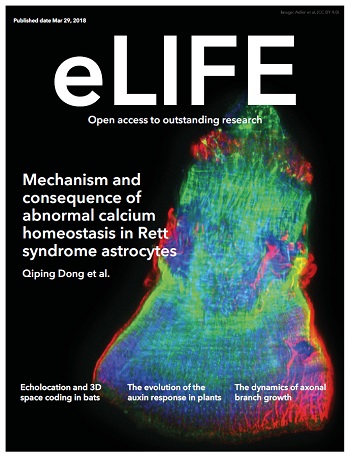通过操纵 KV10.1 的胞内结构域揭示隐藏的传导状态,从而揭示两种门控机制之间的耦合关系
IF 6.4
1区 生物学
Q1 BIOLOGY
引用次数: 0
摘要
KCNH 钾通道家族在可兴奋细胞和不可兴奋细胞中都发挥着相关的生理功能,其功能突变或药理作用的巨大后果反映了这一点。这组通道与其他电压门控 K+ 通道在结构上具有同源性,但该家族的门控机制与这些分子的典型机电耦合机制存在显著差异。特别是,KCNH 通道的大胞内结构域在门控中起着至关重要的作用,而人们对这一作用的了解还很有限。我们以 KCNH1(KV10.1)为模型,描述了一系列现有模型无法解释的改良通道的行为。通过电生理学和生物化学方法以及数学建模,我们发现开放状态可以解释突变体的行为。这种开放状态在野生型通道中是检测不到的,它似乎缺乏传统开放状态的快速闪烁阻滞。由于它是从深度闭合状态进入的,因此它阐明了远早于野生型通道开放的中间门控事件。这使我们能够研究通道开放之前的门控步骤,例如解释 Ca2+-Calmodulin 的门控抑制机制,并生成一个描述 KCNH 通道门控特征的模型。本文章由计算机程序翻译,如有差异,请以英文原文为准。
Revealing a hidden conducting state by manipulating the intracellular domains in KV10.1 exposes the coupling between two gating mechanisms
The KCNH family of potassium channels serves relevant physiological functions in both excitable and non-excitable cells, reflected in the massive consequences of mutations or pharmacological manipulation of their function. This group of channels shares structural homology with other voltage-gated K+ channels, but the mechanisms of gating in this family show significant differences with respect to the canonical electromechanical coupling in these molecules. In particular, the large intracellular domains of KCNH channels play a crucial role in gating that is still only partly understood. Using KCNH1(KV10.1) as a model, we have characterized the behavior of a series of modified channels that could not be explained by the current models. With electrophysiological and biochemical methods combined with mathematical modeling, we show that the uncovering of an open state can explain the behavior of the mutants. This open state, which is not detectable in wild-type channels, appears to lack the rapid flicker block of the conventional open state. Because it is accessed from deep closed states, it elucidates intermediate gating events well ahead of channel opening in the wild type. This allowed us to study gating steps prior to opening, which, for example, explain the mechanism of gating inhibition by Ca2+-Calmodulin and generate a model that describes the characteristic features of KCNH channels gating.
求助全文
通过发布文献求助,成功后即可免费获取论文全文。
去求助
来源期刊

eLife
BIOLOGY-
CiteScore
12.90
自引率
3.90%
发文量
3122
审稿时长
17 weeks
期刊介绍:
eLife is a distinguished, not-for-profit, peer-reviewed open access scientific journal that specializes in the fields of biomedical and life sciences. eLife is known for its selective publication process, which includes a variety of article types such as:
Research Articles: Detailed reports of original research findings.
Short Reports: Concise presentations of significant findings that do not warrant a full-length research article.
Tools and Resources: Descriptions of new tools, technologies, or resources that facilitate scientific research.
Research Advances: Brief reports on significant scientific advancements that have immediate implications for the field.
Scientific Correspondence: Short communications that comment on or provide additional information related to published articles.
Review Articles: Comprehensive overviews of a specific topic or field within the life sciences.
 求助内容:
求助内容: 应助结果提醒方式:
应助结果提醒方式:


